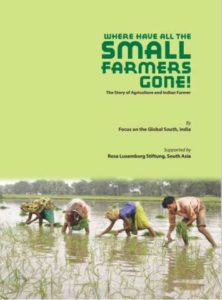08/04/2014
Under: Food Sovereignty and Agroecology, Publications
[In Hindi: Jane Kahan Gaye Ladhu Kissan – Kheti aur Bhartiya Kissan Ki Kahani]
Agriculture is an important sector of the Indian economy, accounting for 13.7% of the nation’s GDP in 2012–13 (down from 30% in 1990–91), and about 11% of its exports, and serving as the principal source of income for about half the country’s population. At 179.9 million hectares, India holds the second largest agricultural land in the world and 4% of the world’s water resources, but has to support about 17% of the world’s human population and 15% of the livestock. With 20 agri-climactic regions, all 15 major climates in the world exist in India. The country also possesses 46 of the 60 soil types in the world. In the crop year 2011-12 (July-June), India had a record food grain production of 259.29 million tonnes.
Despite all this, the plight of Indian farmers, especially of small and marginal ones, is worsening with each passing year. Since 1995, more than 290,000 farmers have committed suicide and around 2,358 farmers are quitting agriculture daily. With the average monthly income of farm households (Rs 2,115) now lower than their average monthly expenditures (Rs 2,700), it is not surprising that the food producers or annadatas who feed our entire nation are dying of hunger and malnutrition.
The neoliberal policy push for the input-intensive, export-led, industrial agricultural model has polluted the very foundations of our agriculture – soil, water and climate – causing serious damage to seed and agro biodiversity, and making farming unsustainable and unremunerative for millions of India’s small and marginal farmers.
Small and marginal farms, however, are still crucial for India’s food security and sustainable agricultural growth. They account for about 85% of the operational land holdings, or 44% of the total cultivated area in the country. The future of agriculture in India depends on the performance of small farmers, but they are the victims of neoliberal policies being pushed through the promotion of export-led industrial agriculture, or the second “green revolution”.
In India and elsewhere in the world, there is a growing movement to usher in change in the agriculture system to save small and marginal farmers from the onslaught of the second green revolution.
Focus on the Global South, with the support of the Rosa Luxemburg Siftung, has started a collaborative program me to bring out educational materials and other publications focusing on the small and marginal farmers. These will highlight their concerns, and attempt to grasp the various governance issues that have made their survival precarious. The publications will also feature the different aspects of the present neoliberal model of agrarian reform in India, exploring how it impacts the viability of small-scale agriculture.
We will also make special efforts to highlight the alternative technologies and mechanisms based on sustainable and agro-ecological principles that can make these small farms not only viable and self-reliant but also profitable. There is an urgent need to instill confidence among the small and marginal farmers that small farms can be viable and sustain their livelihood. It is also important to debunk the myth that only big farms are viable.
This booklet, “Where Have All the Small Farmers Gone?” is the first in the series, and it traces the broad history of the rich agriculture system in India which was ruined by the British colonial policies. We hope that these educational materials will help initiate conscious dialogue and interaction with and amount small farmers, helping them realize their strengths, retrieve their sense of dignity, and overcome the obstacles through their own initiatives, by enabling them to take decisions regarding agriculture.
Afsar Jafri
Focus on the Global South




![[IN PHOTOS] In Defense of Human Rights and Dignity Movement (iDEFEND) Mobilization on the fourth State of the Nation Address (SONA) of Ferdinand Marcos, Jr.](https://focusweb.org/wp-content/uploads/2025/07/1-150x150.jpg)

